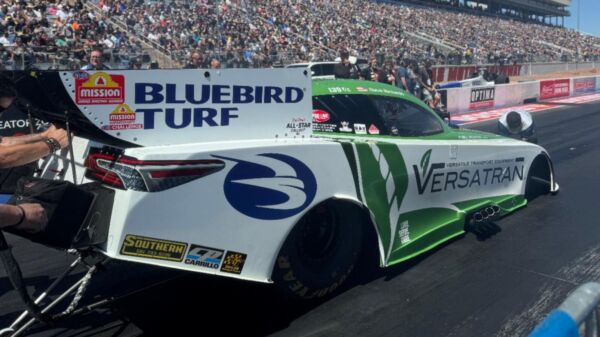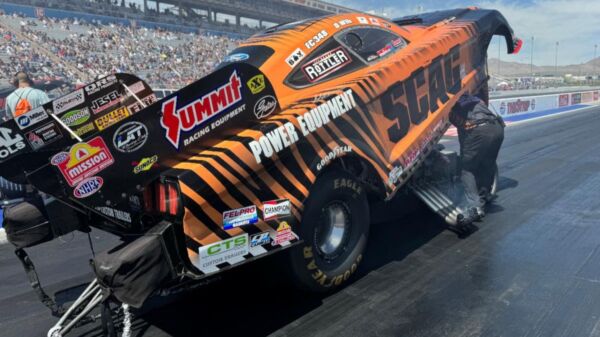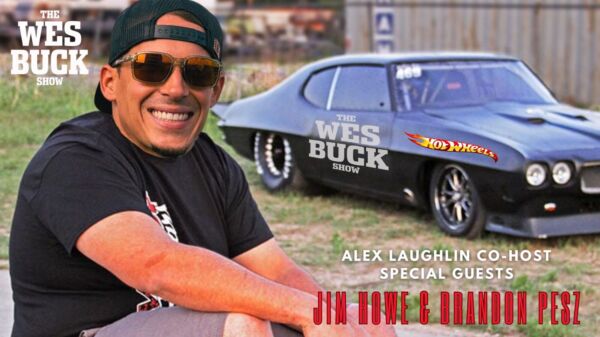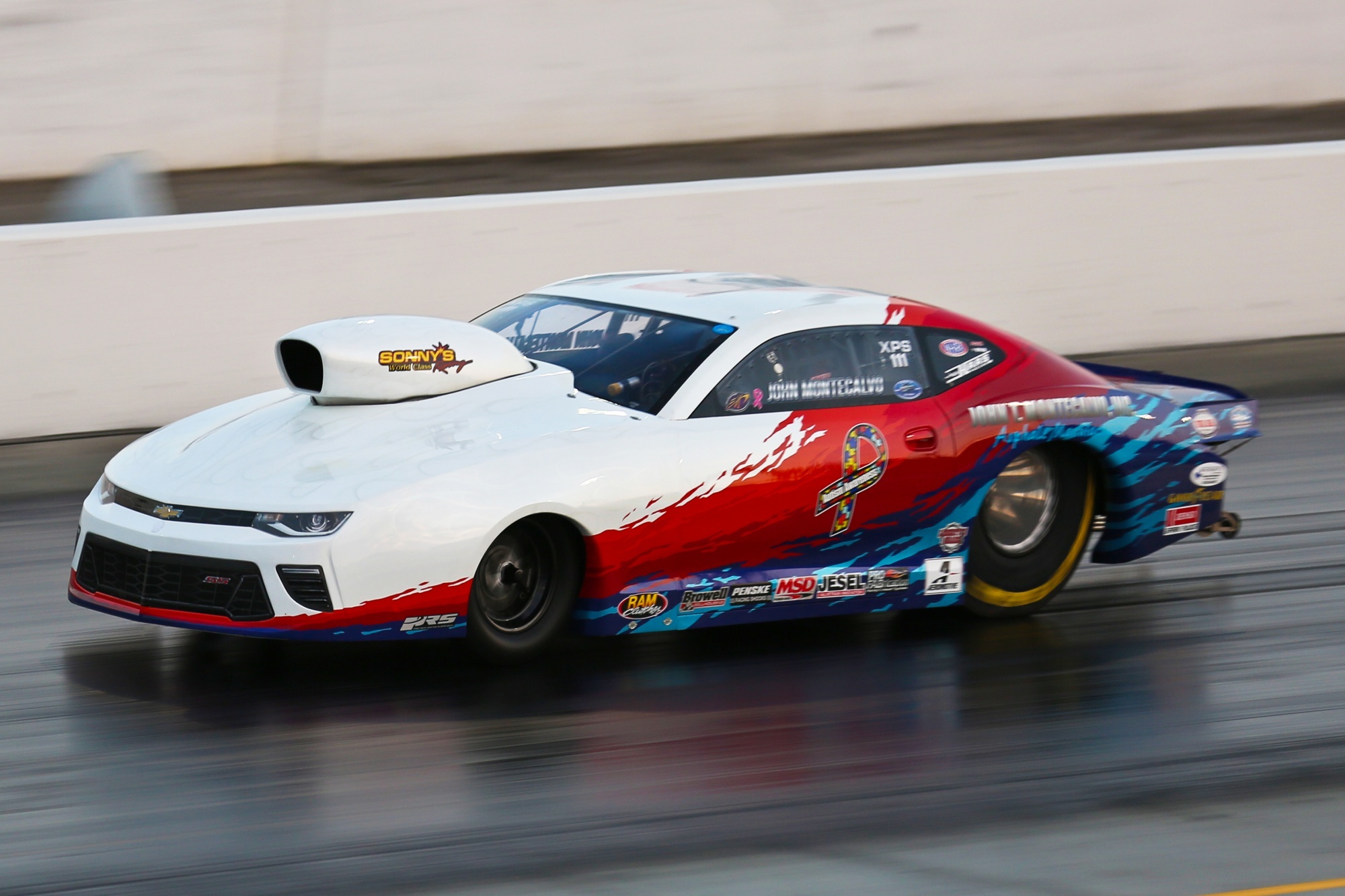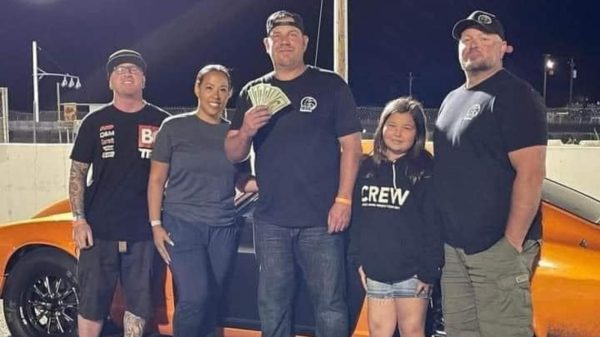Evolution in drag racing is inevitable, but when it comes to the doorslammer ranks, it’s almost been astronomical over the last decade.
We’ve seen drag radial racing – and most notably, Radial vs. the World – explode onto the scene, Pro Mod become as popular as it ever has been and Pro Stock take a number of massive steps to switch up the class, finally finding some sort of positive footing during the last couple seasons.
[Editor’s Note: This story originally appeared in DI #158, the State of Drag Issue, in July of 2020.]
Mountain Motor Pro Stock remains in a world of flux, but dipping its toes into the NHRA ranks could put yet another doorslammer class onto a road participants hope will rival its heyday.
Combined, there’s no doubt much has changed in almost every area. Doorslammer racing looks nothing like it did just 10 years ago and there’s plenty of positives — as well as a few negatives — that accompany that.
To take a deeper dive into the evolution of doorslammer racing, Drag Illustrated talked with a panel of standouts spanning the full spectrum of door car racing, including Pro Stock, Pro Mod, drag radial and MMPS. Each touched on how the class has evolved, the challenges and biggest advancements in technology, predictions for the future and more.
As wildly different as the classes are, the answers showcased the different spot each category is currently in, where it came from and the biggest factors toward continued growth.
Greg Anderson is one of the biggest legends in Pro Stock history. He’s been both crew chief and driver, giving him an interesting perspective as Pro Stock moved into its current EFI era.
Mark Woodruff is one of the originals when it comes to drag radial racing, witnessing the dramatic rise of Radial vs. the World. It’s also left him with strong opinions about what’s helped the class succeed.
Chuck Samuel is a standout crew chief in the Mountain Motor Pro Stock ranks, helping lead Cary Goforth to his last championship, and currently tuning the likes of standout Chris Powers.
Tommy Lee has been a successful driver and tuner in both the NHRA Pro Stock and MMPS ranks, driving during the biggest run of success for the class. He’s currently the tuner for multi-time champ John Montecalvo.
Doug Winters is a veteran who raced Pro Mod and Nitro Coupe in the Super Chevy days and is now a standout driving full-time in the NHRA Pro Mod ranks. There’s been significant changes – which he views as pluses and minuses – in his time in the class.
Charles Carpenter, known as the “Godfather of Pro Mod,” is a legend in the Pro Mod ranks. As one of the original pioneers in the class, Carpenter has seen – and done – it all, marveling about the incredible advances in the class.
The evolution of doorslammer racing has taken on many forms over the years depending on the class. For your particular class or area of expertise, what stands out most to you?
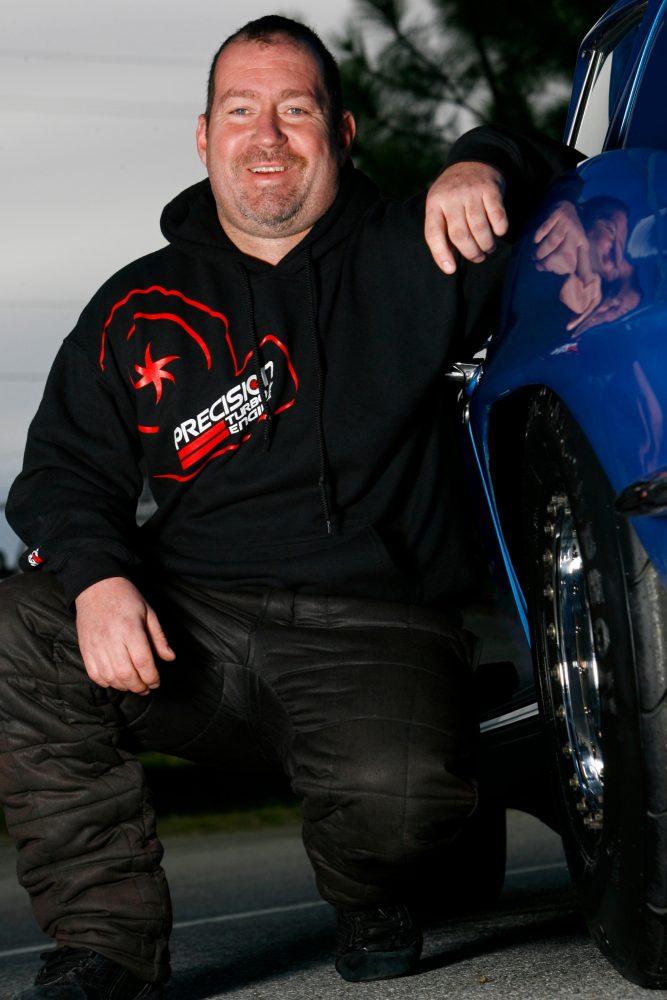
Mark Woodruff
Mark Woodruff: I think the evolution of track prep, the rule-makers, and the guys that are involved in making the rules and trying to keep parity across different power plants has been huge. I mean, you look at the different combos that are out there, and if I’m going to look at drag radial or RvW, or X275 or anything like that, what makes it exciting is that anything can be competitive there. It’s obvious Stevie Jackson, and KTR [Killin Time Racing], I mean, they’re bad asses, and it doesn’t matter what combo you give them.
But to compare it to other doorslammer racing, you look at even when the hype of Pro Extreme was going on, it was a true blown Hemi, super lightweight, no rules. That was the combination to go race. RvW could be nitrous power, it could be a twin-turbo car, small-block or big-block, it could be a ProCharger car. It’s like where can it go? I think if you have the right conditions, you have those mineshaft air conditions, you’re going to see cars go 3.40s.
Greg Anderson: Well, obviously the biggest change that we’ve seen in the class for all the years that I’ve been involved has been this change to fuel injection. That was a serious, serious fork in the road for us. Before that, it was pretty much an all-out assault to try and make more power with your carburetors and try to make your engine run as high an RPM as you possibly could and that was the direction that everyone went for 20-30 years, at least, in the class. Any time you gained on making the engine run a higher RPM, or things like that, you ran better at the racetrack.
So that’s what the goal was and obviously there’s a rulebook, but there was a lot of room to work and it gave you a lot of latitude to do a lot of different things to the engines and create different things, and then when we made the big swap to the fuel injection, it wasn’t only a change away from carburetors to fuel injection, but it really cut down on a lot of latitude that you had on what you could do with the engines. They capped the RPM and they made different rules for this, different rules for that, different rules of where you had to bring the air in the front of the car. Everybody had to do it the same. It was a big change. It wasn’t just a fuel injection change, it was a clamp down on the latitude you had to try and find horsepower, basically.
So it’s been different the last two or three years, and I guess if you’re a guy that joined this class years ago, that’s why you joined it, because it had a lot of latitude. It had a lot of room to roam and a lot of room for creativity and basically anything you could dream up, you could go and build yourself and take to the racetrack the next week, but it’s not necessarily the way it is anymore. It probably had to be reined in a little bit, but it’s been a different way of racing for the last three or four years, for sure.
Charles Carpenter: It was always kind of a steady movement for a fast door car. But I guess what things that stick out in my mind, of course, are the big milestones, like [Bill] Kuhlmann’s 200 mph run, and the 7-second [run], into the 6-second stuff. That’s such huge, monumental gains when you’re getting into a different second, so to speak.
Those things always stick in my mind of where this stuff has gone. Speed, aerodynamics, things of that nature, all the stuff that we’ve learned through the years with this class, it really is mind-boggling to think now that we’re going 200 mph in an eighth-mile. I was one of the first cars to go 200 in the quarter-mile, and it was a huge milestone to go 200 back then.
I think back to where even it was a milestone to go 100 mph in an eighth-mile and just to think where this stuff is going now, it is just totally mind-boggling. Technology, our parts, the things that we used back then in the early days of it, we were still modifying a lot of stuff. I mean, it was maybe performance-intended, but it certainly wasn’t intended to do what we were doing.
They make us a better part that was great from where we were, but we’re going to immediately find the limits to it. The equipment that we have now, I mean, I have stuff that’s technically outdated, but we do pretty well with it, but it’s the best stuff that I’ve ever had. To run what we run with it and to make the number of passes that we make on it with practically no damage, you can run these things at least a weekend and maybe two and sometimes three without having the engine apart.
In our world, that’s a major thing, but it is all just evolved to a level that I never dreamed of. The popularity of door car racing, I mean, I love it. The people love the door cars, but it’s good parity.
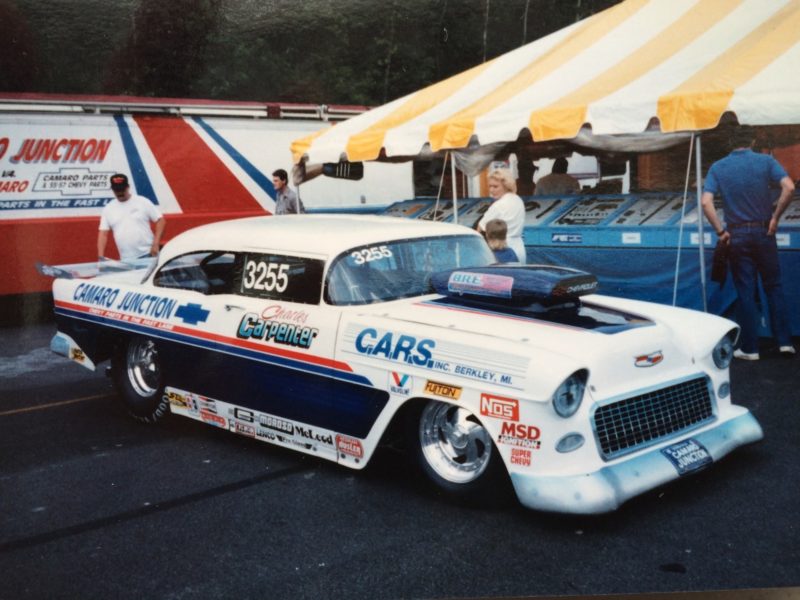
Charles Carpenter
Tommy Lee: In the mid-90s to late-90s, the record back then was in the 6.70s and 206, 207 mph. I think at that time they made 1,350 horsepower or something like that, and now they’re pushing 2,000 horsepower. That’s even happened long before this. There’s guys with motors built in 2008 and 2009, they’re just as competitive as some of the new stuff. So it all happened in probably in a 10-year span there.
I don’t think EFI has been a challenge for the Mountain Motor cars because they’re able to run the same basic intake manifold with just the throttle body setting on top of that, and they’re allowed to run 16 injectors in. So it’s got eight injectors down in the runners, and then they got eight injectors right under the throttle body, and I haven’t seen that the fuel injection is really any faster or has an advantage.
I think with the way things have gone since 2008 or 2009, there’s not as many people investing in Mountain Motor Pro Stock engine supplies. So I guess the reason why the class is kind of a little bit stale right there, is because there’s been no new money coming to the class to further advance development on the engine.
The IHRA pretty much ran the Pro Stock cars off, and run everybody off now, but it was so iffy to where you could run a Mountain Motor Pro Stock car, and there’s a lot of guys, they don’t care for the eighth-mile racing either.
Doug Winters: Technology, obviously, is the first thing that comes to mind in every class, but Pro Mod is one of the hypersensitive ones for technology, whether it’s power, electronics or whatever aspect, the technology we gained in the Pro Mod class is a lot because it does involve blower cars, nitrous, turbo cars and all that.
 There’s a bunch of things when you start to look into it. I’m an electrical engineer at heart and if you look at all the devices that can create more power, it’s a lot.
There’s a bunch of things when you start to look into it. I’m an electrical engineer at heart and if you look at all the devices that can create more power, it’s a lot.
What has surprised me is the willingness of the sanctioning bodies to let it happen. I’m an old-school guy and I still think a pro car should have a clutch. If they came around the pits and said no more Pro Mods can have auto shifters or trans brakes, I’d say, “Great, let’s do it.”
Technology has advanced so far, you really don’t need to be an awesome driver. Back in the day, 90 percent, if not 99 percent, of us drivers were tuning on the cars, working on the clutch, doing everything we can do be competitive. These days, it’s computer-controlled.
I think the class has done well. It’s grown with the ability of all the different aspects it has, but I wish it would have grown a little slower. I wish we wouldn’t have lost some of the differentiators of the class. You see a lot of late-model Camaros. I just wish some of those aspects were still there, maybe more manual than automated now.
With that evolution, there’s growing pains or possible steps backwards. What has your class fought as things have evolved as rules have changed, and as popularity has surged or waned?
Chuck Samuel: Because Mountain Motor Pro Stock is a manipulative class, you got to work on the race car to make it faster. And I think racing in general is going away from that. I’m not going to say technology hurt this type of class. I’m going to say that you still have to work on the race car to race it, and the generations of people that do that are getting further away just because of computer tuning, traction control, different trends. It’s not as, let’s just say, marketable as some of the other types of classes today.
I mean, the amount of power that you can add, you can always take it away but I’m just saying you can’t just go ahead and swing at it and add power. You can’t add boost, you can’t add nitrous, you know what I mean? What you have under the hood, and they call it the hood scoop support, is really all you have. So in order to race you have to be pretty savvy on how to do it: gearing, weight balance, RPM, driver ability, and then work on the race car to make better and faster passes. So it’s a difficult class in that regard. My belief is that’s why it’s thinning out because it’s not as culturally cool today. Everybody wants to buy parts and laptop tune, you know what I mean? It’s just a different way of doing it. It’s like powerboat racing versus sail boating.
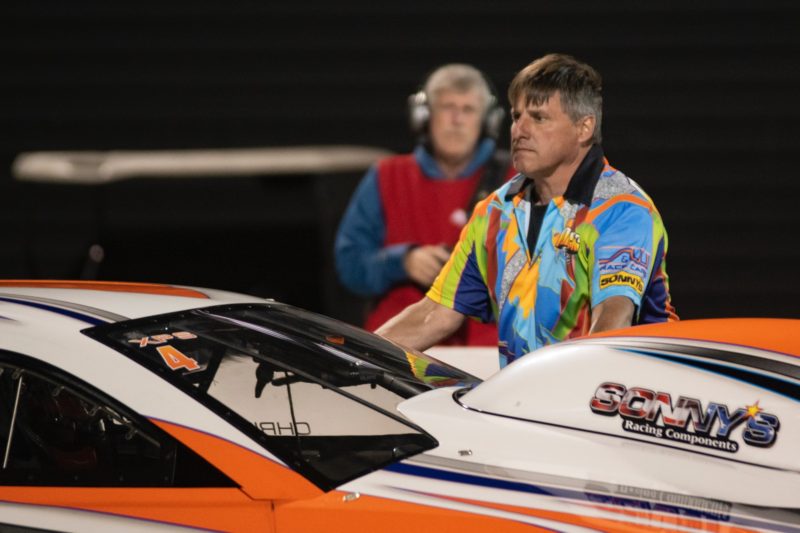
Chuck Samuel (Cole Rokosky photo)
GA: You really just can’t do that much to the engines anymore. So it really cut out on a lot of the R&D we had and I think if you asked any of the major engine builders in the class right now, we’ve probably spent less on R&D on these engines in the last three years than we have in our whole careers.
It definitely made it different, a different way of doing it. Obviously, it put the emphasis back more on the driver, the cars all run closer to the same and make close to the same horsepower, so it’s put a lot of emphasis back on the driver and that’s another different element. Some people like that, some people don’t, but that’s the way it is. There’s no sense complaining about it, I can’t change the way it is. You’ve got to learn to deal with the things you’ve got to do better.
I’m not going to lie to you, I liked it the way it was before because I grew up as a mechanic. I learned to work on things, I didn’t grow up as a race car driver. I never even had a dream of driving a race car. I wanted to work on cars. I wanted to work on cars and engines and I got my training growing up working at my dad’s car lot doing every type of work that could be done to an engine, to a car, to bodywork, front bumper to rear bumper. So I’ve been a mechanic all my life and that’s what I love about it. That’s why I joined the class, so it’s been a different change for me.
A lot of people that do nothing but drive the race cars, it’s probably more appealing to them, no question about it, but an old-school guy like myself or Jason [Line], that’s what we grew up on. We grew up as mechanics and trying to make your mousetrap better and the reward for it is when you get to go sit in that race car right down the racetrack, but it’s just a different way of looking at it.
The evolution curve is certainly different among the doorslammer ranks when it comes to performance gains. It’s been massive in classes like Radial vs. the World and Pro Mod, a more small, consistent upswing in Pro Stock and more of a slowed, stagnant growth in MMPS in recent years. What have you seen in that regard?
MW: The only thing you can even compare RvW to is Funny Car or Top Fuel, and whenever you have more power than you can possibly use, the technology that’s behind it, every one of them cars makes between 4,800 and 5,500 horsepower.
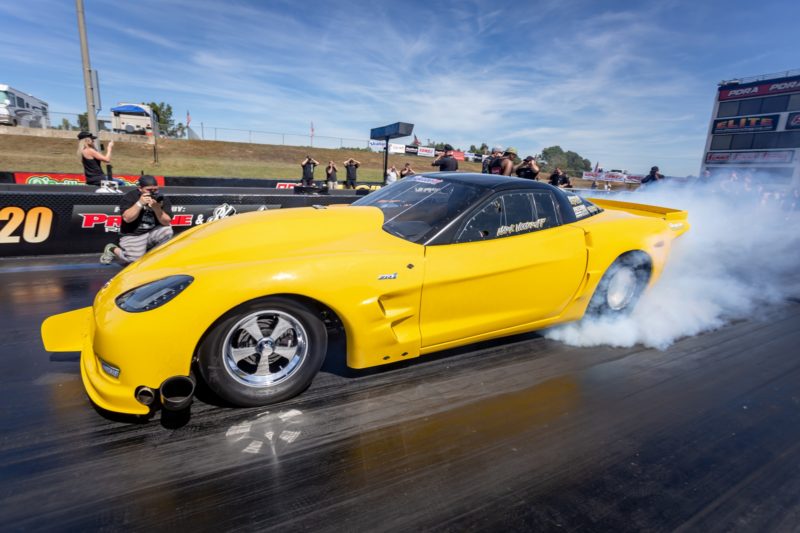
Mark Woodruff (James Sisk photo)
It doesn’t matter if it’s Radial vs. the World, Pro 275, X275, these are not cheap cars to run, and along with that, you take the top guys in any class, and there’s not a dummy amongst them. And some of the best racers are there, too. I’m here to tell you that there’s some badass radial racers too. I mean, they’re no joke. Stevie’s proven that by going and winning a world championship in NHRA, and I believe that he’s going to be a Top Fuel champion someday if he finds the funding and the money to go do it.
You just look at the level of competition that’s there and, no, I’m not surprised of it at all. I really think that the grassroots racer that’s there in RvW, you’ve got the cream of the crop. Quite honestly, looking at Mark Micke, he’s done so much for drag racing and converter technology and transmission technology, and then to be out there on the racetrack doing it and proving his products and taking the evolution of torque converter and transmission technology. I don’t know any other transmission company out there doing that or a torque converter company that’s out there racing, physically out there in the battlegrounds, with the best of the best.
You go and you give the best prepped racetracks that you’ve ever been on, you can go try things that you’ve never been able to try before. And then you learn. After you’ve learned you can apply that, and a lot of the things that we’ve learned in RvW, we’ve transferred over to a Pro 275 program.
DW: Years ago, you never looked at split times. Now you get that time slip and you’re looking for a hundredth or a half of a hundredth trying to improve each one, whether it’s your 60-foot, what you’re running to 330, 330-660 or the back half. You’re taking each one of those segments and break each one down looking to improve. Now you’re tuning around segments of the track looking to make up time.
CC: Having a power adder is what makes the difference, too. I mean, Pro Stock, they’re awesome with what they do, and they’re trying to find thousandths and we’re trying to find hundredths at least all the time, but having a power adder is what makes that difference or that gap different. It makes it a wider gap with us, but there was always a natural evolution.
If you had new parts one season, you could usually run them a couple of seasons on it and then if you were improving that part or your parts during that time, then you could sell and move up to new parts again, and you could stay in that top 10.
But with the influx of all the money that came into the class 10 years ago or whenever, when it was during the ADRL days, it took that natural evolution and raised the bar higher than a guy like me could keep up with. Now with the technology that’s out there, the stuff has come back to a point that a guy like me can do it.
We’re doing it with stuff that’s [2015], ’16 model parts and, I mean, we’re not going to run at the front, but we can run in the middle, and there’s other cars just like me out there. A 10-year old [Jerry] Bickel car, there’s nothing wrong with them. The cars, they work great, and so a 10-year old Bickel car and a 3-5-year-old engine combination with the latest ad-ons and stuff like Brandon Switzer with his fuel injection and you got Mark Micke’s transmission and converter, and you got the stuff that the latest greatest some of the parts, but with that stuff you can run. You can compete and be there. If you get in the middle of the field and just go down the racetrack every time, you might not win, but you will win eventually. You will win sometimes.
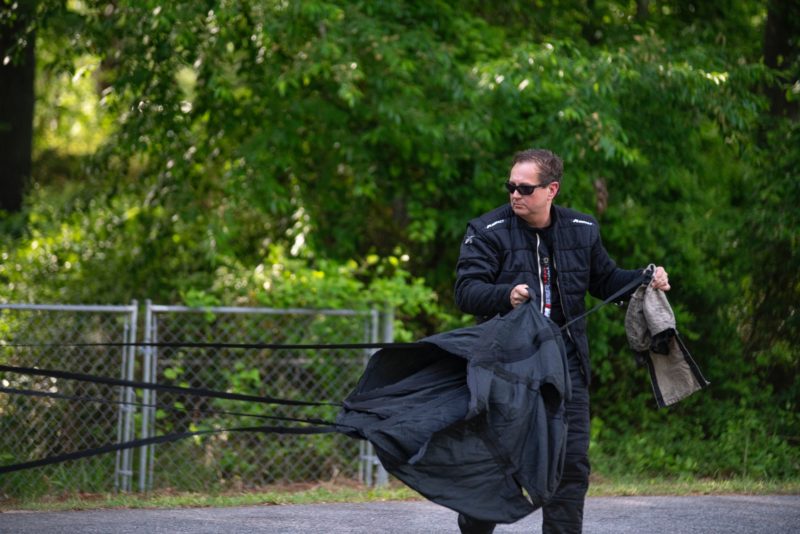
Charles Carpenter (Cole Rokosky photo)
CS: Unfortunately, what makes [MMPS] look stagnant from the outside is that there’s no fast gains on the scoreboard. The field didn’t move forward that much faster. The lead numbers and the top four or five cars are pushed up against the front. And yes, they’ve nicked the world record here and there, and they’re a little bit faster, a little bit quicker just working on the old combination, get new cars, better racetracks, better tires, all of it. So you’ve got three or four cars that kind of hang in the front and they work forward a little at a time.
As time evolves, the guys way in the back of the pack move up tighter and tighter and tighter. So you’ve got a guy that could have been 2-3 tenths off the field, now he’s five hundredths off the top three or four.
Everything, every round, every time you make a decision, everything has to be right in order to move forward, and one thing needs to be wrong to go the same or backwards. And it’s pretty easy, like simple things — you miss a shift by a little bit, you miss on the clutch, you put a half a degree too much or too little timing in the engine, all of a sudden you didn’t go anywhere.
And you have to buy good engines. You can’t go buy a slouch engine and be on the top of the page. You’ve got to get some good power because it’s really all you race with. You could be the best racer in town, drive the car the best, got the best light, if you don’t have enough horsepower to get in the game, you’re going to be in the back of the pack.
That evolution has included a lot of advances in different technologies that has aided performance. Again, for your specific class or area, what do you see as the biggest advancements in technology?
MW: Well, the transmission converter technology, no matter if it’s a five-speed Liberty and a screw blower, or if it’s a M&M transmission, a three-speed 400 turbo lock up deal, that’s been the biggest advancement of anything. That along with the track prep and then you got to go and you look at these ECU companies or these fuel delivery systems. I mean, they’re so smart in the things you can do with them. And you give the best tuners in a world that then let them collect data for two or three years. We learn stuff every time we go out. We tried different stuff with mine and we learn it, and the next thing you know, they take that back to somebody else that they’re working with. That really becomes the evolution of how we excel at the sport.

Greg Anderson (Mark Rebilas photo)
GA:You know, there hasn’t been one major thing. I think what finally, everybody realized that it wasn’t just the engine that was going to make you go with in this class, and it wasn’t just the driver that was going to make it. You have to have everything right. Your car needs to be perfect from front bumper to rear bumper, and when we all started paying more attention to every aspect of the race car, every piece of the driveline in the race car, that’s when we all started going forward. So they became way more refined, and if you look back 10, 15 years ago back when I worked with Warren [Johnson], you didn’t spend a lot of time with all the other components in the rig, in the car.
You just worked on that engine. Anymore, you’ve had to look in all the other directions. I’ve kind of seen a lot of finessing and a lot of fine-tuning with every piece of the race car itself from the front bumper to rear bumper over the last 5-10 years.
I’ve worked on a lot of different things, and obviously working with Warren for all those years, you learn to work on every single thing. You don’t just learn one job and you have to learn to work on everything and that’s kind of the way he was. That’s what I learned from being with him. You work on a lot of different things. As soon as I started this team, we hired people that were good at maybe this part of the job, and then someone else was really good at this part of the job and another person that was good at that part of the job. We really scratched all the surfaces from front to rear of the car and the engine.
CC:In my eyes, the torque converter, fuel injection, tires, and track prep. To me, those are the things that really allowed this stuff to take off. I mean, I’m a clutch guy, I’m a 40-plus-year clutch guy and I had never sat behind an automatic until five, six, seven years ago whenever I started playing with them. And I hated it at that time just because it was a change, but when I look at it now, there’s no way you can’t do it. You couldn’t do it with a clutch.
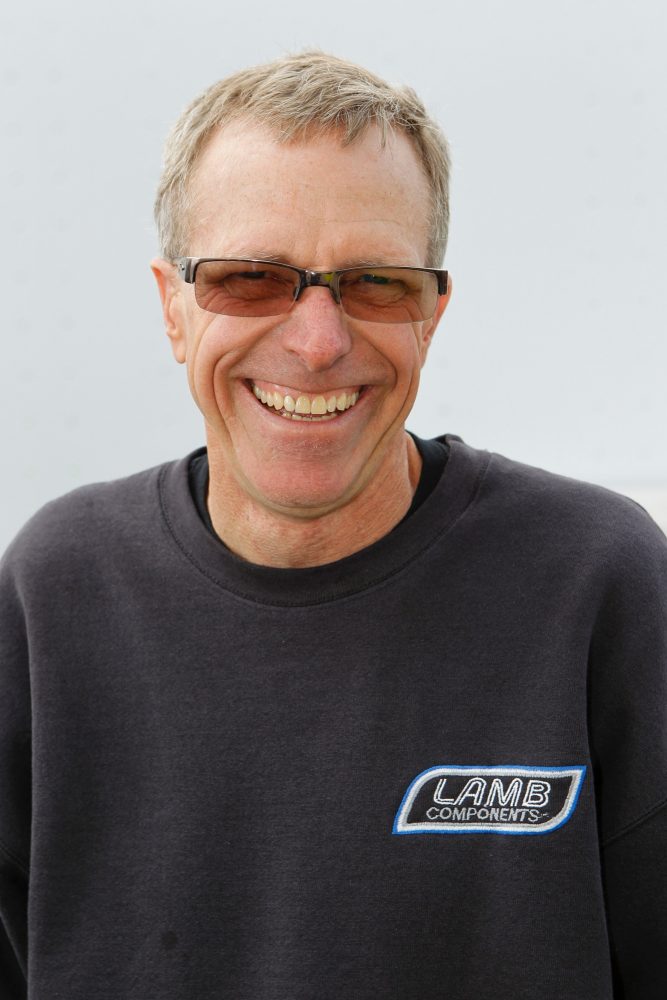
Tommy Lee
It’s the smooth transition of power, and to be able to apply the power, that much power that early and how quick we turn on all our nitrous systems is all so important. That’s the key. The early numbers are what makes or breaks, especially on an eighth-mile race.
It takes all those things, though, to do it. The fuel injection to be able to put the fuel where you need it at the different loads of the engine, and then the torque converter to be able to apply it and then the tires and the track grip to hold it.
TL: I think it was camshaft and cylinder head technology [in MMPS]. When I first started racing, we’d run our springs all year, and now you can’t do that. A lot of times you’ll replace two or three springs in a race, especially when it was quarter-mile racing, it’s a lot harder on springs. But it’s definitely been camshaft and intake and cylinder heads.
The camshaft, they got more aggressive on the lifts, and cylinder heads, I’m sure they went to bigger valves in them and opened up the heads. So, you did gain a few cubic inches, which helps.
If you stepped back a decade, you likely couldn’t have predicted doorslammer racing would go in the direction it has. Where did you see this going 10-15 years ago?
GA: I think back then, I would have said each year goes by, we’ll gain 10-15 horsepower with the engine and that’s going to continue because it did for so many years. But that stopped. That’s gone away. I didn’t perceive that coming, but that’s absolutely gone away. And nowadays, if you gain five [horsepower] a year, you did it, you had a great year. So that was not the case for many, many, many years in a row. You didn’t find 10, 15, 20 horsepower in a year, you got left behind and just like everybody, it has to every year. But with all these rule changes, that has kind of come to an abrupt halt.
MW: Well, 200-plus mph was quite a milestone. I mean, you look at throughout history, now you’ve got drag radial cars that are going 221 mph in the eighth-mile. I had a friend of mine, he’s followed my racing and he’s a car guy, but truly doesn’t understand what we’re doing. He follows drag racing, he’s like, “How fast do you think your car would go quarter mile?” And I’m like, “Well, really fast.” And he’s like, “What do you mean?” And I’m like, “If we geared it, and we put a three-speed transmission with a lock-up in it or a four-speed Liberty or a five-speed Liberty with a lock-up to where we could run the quarter-mile, I mean, seriously, a drag radial car could go 300 miles an hour.” When you put that into perspective that it would be capable of doing that, or close to it, that’s unbelievable.
Whenever you think about that type of stuff, and the evolution, it’s just crazy. I mean, they’re defying physics. I mean, that’s all that you can say. It’s crazy.
CC: I would’ve projected that these cars probably would be two-tenths slower than they are now. I mean, I would have never dreamed that they would be where we are today. I’ve had a good gauge of this stuff and I’ve been involved in it at a level that I’ve seen it change and grow and I’ve looked at it, but I would’ve never ever dreamed it would have got to this point. I really would not.
For what knowledge and skill that I have, [the evolution in technology] allows somebody like me to be able to take that stuff and race it. And there’s a lot of guys like me, but it allows you to extend your racing career and what you could do and be able to go and compete, and that’s been very satisfying.

Charles Carpenter (James Sisk photo)
With this evolution, how do you balance some of the technology advances, especially when you’re looking at more of the computer technology with the mechanical aspect of this?
DW: Again, I’m an electrical engineer at heart. There’s a fun aspect of taking all the data you can get and figuring out how it works better. I do enjoy the computer aspect because it comes back to my engineering background, manipulation of the data and trying to find ways to improve.
But it’s tough because there’s so many variables out there and everybody is so competitive. You’re trying to manipulate the variables from the computer. It’s a very challenging mix. It’s just understanding what you can and what you can’t do.
Do you take some timing out to get the car down the track, or what if you want to change the suspension? It’s trying to change as few variables as you can, and you have to test to be able to do that. If you don’t touch the timing curve, you’re making adjustments to the gear ratios, the transmission, air pressure in the tires, or maybe it’s the four-link settings or the shock settings. It revolves around more and more testing.
We used to never test. I remember Scotty Cannon saying his dyno is that red Willys out there running in Q1. These days, you can’t do that. We’ve been to Darlington three times this season and haven’t been to an NHRA race yet (note: this interview was done before the NHRA Pro Mod opener at Indianapolis in mid-July).
We’ve already changed the rods twice this year, but you’ve got to test or you’re going to be behind. We could always use more testing, but we do what we can with the ability of time and money. We’re at a point where we’re happy with the performance we have and the time and resources we put in to do it. We’re competing with guys that all they do is work on their cars or teams. I’m pleased with what we’re able to do. It all goes back to how competitive we are with the time and availability we have with our team.
GA: Between the group of us here [at KB Racing], I don’t think most of us could turn on a laptop computer, let alone program the damn thing, so it’s been a steep learning curve for us. It’s been interesting, but I’m telling you, you feel so stupid sometimes and it absolutely is smarter than I am, smarter than we are, no question about it and we’re trying to catch up with the brain box that they call this computer, this EFI that runs it all.
It’s been a challenge. Yes, we had success, but I’m certainly not going to stand here and say it’s because we were smarter than anybody. That’s absolutely not the case. Somehow, we did some things better than other people did right off the bat and it took a little while for everybody else to, I guess, learn it the way that these things wanted to be run.
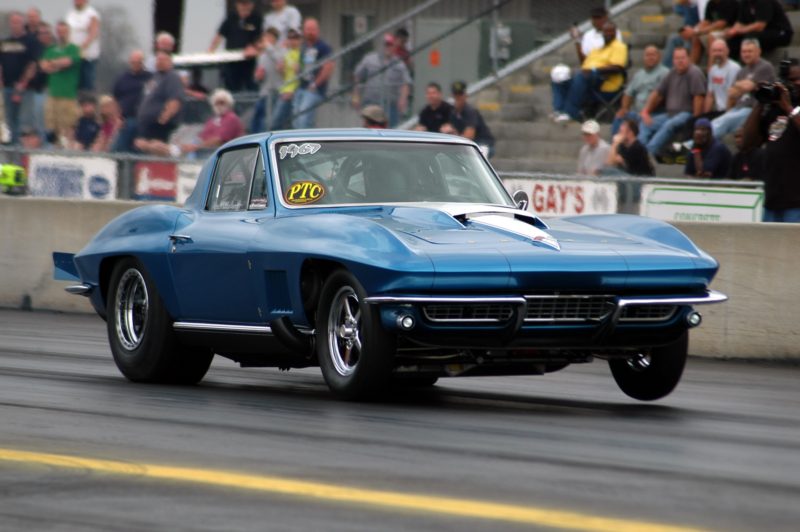
Mark Woodruff
How does this evolution continue to take shape in the doorslammer ranks, and what’s needed to make sure those advancements continue to be smart ones for the health of the class moving forward?
MW: Well, I think you’re going to see Radial vs. the World fall off to a point. I’m a purist. I like a real car. To be competitive in RvW, I mean, you got to have a Pro Mod. I think it ought to be steel roof, steel quarters, stock wheelbase, unlimited. I wish [Donald Long] would’ve not done Pro Mods, and then open it up. Let it be whatever – you want to come in with a Top Fuel motor on nitro, send it. If you think you can hold onto it, let’s do it. And I believe that that’s where I would have liked to have seen it go, but it is what it is.
I hope in Pro 275 the Pro Mods are eliminated from it. We’ve politicked and tried to get the rules changed. And it looks like that they happen to keep the Pro Mods out to where it’s a stock wheelbase, a steel roof and quarter, stock, real-type car class.
And I think that that’ll be the next big thing. I think even Pro Stock whenever you start talking about Greg Anderson and different things like that, I mean, if they don’t feel like they’ve got a performance advantage of some kind to where they’re going to run up front or have a chance of winning the championship, why even show up and spend the money. It’s cheaper to stay at the lake.
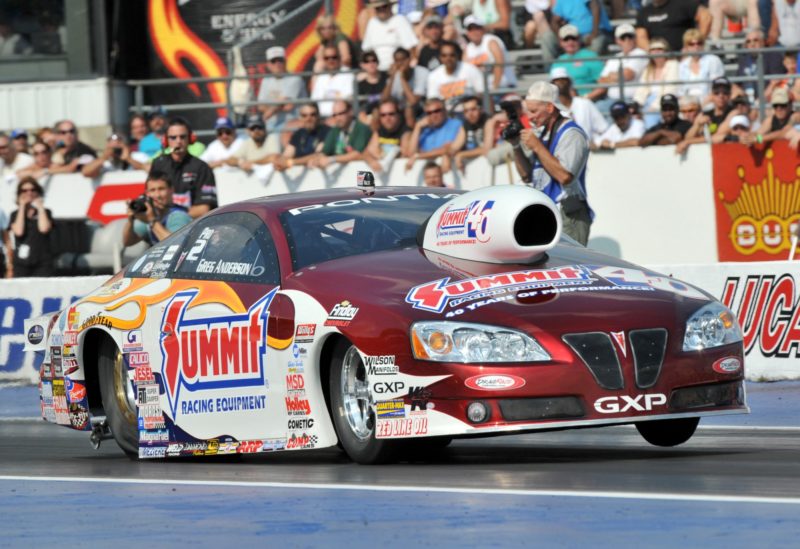
Greg Anderson
GA: More of what we’ve done over the last couple of years, we’ve made it to, where it used to be that you had two or three people that built engines and they were the kings of the class, and they won the bulk of the races.
We changed that philosophy years ago and mainly the reason we did that was we decided the class was going downhill in participation. This was a way to do something different, to make the class stronger and make the class survive and grow over the years, and we kind of all decided that the strong teams – strong into the building game – start leasing engines, leasing complete operations, cars, everything, to basically whoever wanted it. You would lease the same exact equipment that we spent hour after hour on.
That’s the philosophy change. It has had a great, great effect on participation in the class. That’s made the class more popular and it’s made it, I think, more interesting. It’s a different way of doing things, but we changed that mindset years ago and it’s definitely what’s made this class better. So I guess that’s the future. That’s what we need to continue to do.
CS: All I’m saying is somehow or another, there needs to be revitalization of new blood [in MMPS] because for every year that goes by, one or two older guys drop out and zero or maybe one guys show up. If there’s not enough returning, there’s no reason for new guys to get excited. You can’t build a class with no excitement in it.
CC: I see gains still being made. I mean, I think they’re going to be a little smaller. I think we have reached peaks where it’s going to take some real testing. All the true racers and the guys that are really running it in front, they found the limitations of these parts. They’re finding the limitations of them by trying to go faster and trying to go quicker and faster, and you’re working within the confines of the rules that they make.
I hope they keep those rules, but if they keep what we have now, it’s going to slow that game down a little bit, I think. I still think there’s as much as a tenth of a second, possibly in a quarter mile and maybe that much in eighth. I think the eighth mile, I think this year in good conditions, you’re going to see some high 3.50s from a nitrous car.
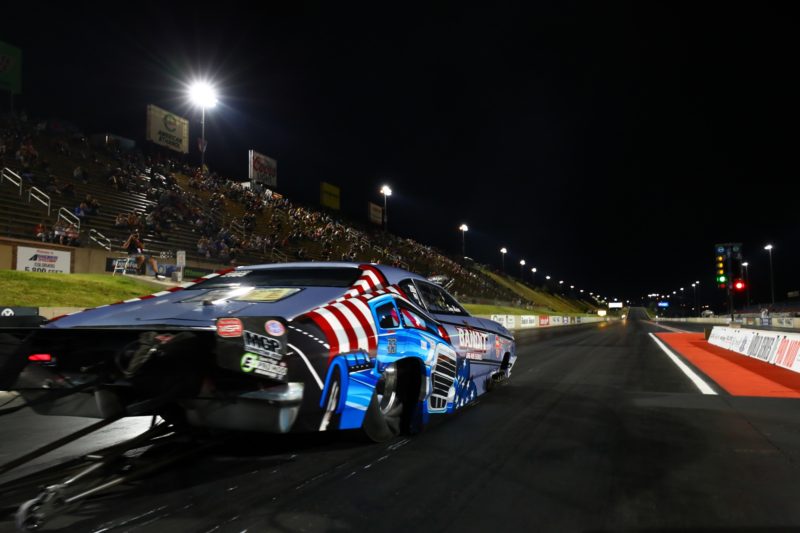
Doug Winters (Joe McHugh photo)
DW: You have to be in control of things. If you bring in another power adder, it has to be put in under control. You don’t want one combination running away with it. I would like to see a situation where, start saying if you’re running a late-model Camaro, you have to add 25 pounds the first year and add 50 the next year so people would think about building another car. I wish they would do something like that to differentiate the body styles.
You look at the entry lists and it’s almost all new-style Camaro bodies. I really hope they address that in some fashion. Forgiving a nostalgia-era car by giving it a weight break doesn’t really work because they’re not aerodynamic enough to make up for it. It’s not advantageous to have less weight in a nostalgia-era car. Adding the weight is the best way to do it.
TL: I’d hate to see [Mountain Motor Pro Stock] go. To me, it’s one of the most economical classes to run. You can still go to an engine builder, buy and own your engine, and you can be competitive. I think a good solid schedule [would help]. I know some people and myself think that if the NHRA would do six or eight races for the Mountain Motor cars, and highlight them like they did last year and promote us like they did last year, I think you’ll see a few people come back into the sport or hopefully new people come in, and get interested in the class.
People would go and run and try the field out, see what they like, and if everything went well, then you might see people invest a little more money. And if they saw the class was going to maintain, and be secure, then they could maybe invest some money. There’s really no place to run this Mountain Motor if it’s not in the Mountain Motor class. Because it’s not a good car for them to make a tight motor to go try to run something else with because it’s so big, you have to put so much weight in the car to get it to run a class, and there’s not too many drag racers who want to have to put 200-300 pounds in a race car.
There’s enough cars that could support both PDRA and NHRA, if the racers come out.
This story was originally published on August 25, 2020. 


